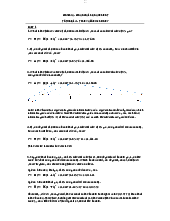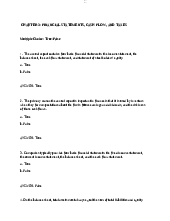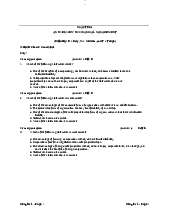

















Preview text:
lOMoARcPSD|44744371 lOMoARcPSD|44744371
DERIVATIVE AND RISK MANAGEMENT MCQ ■ Multiple Choice 1)
The payoffs for financial derivatives are linked to
(a) securities that will be issued in the future.
(b) the volatility of interest rates.
(c) previously issued securities.
(d) government regulations specifying allowable rates of return. (e) none of the above. Answer: C Question Status: New 2) Financial derivatives include (a) stocks. (b) bonds. (c) futures. (d) none of the above. Answer: C
Question Status: Previous Edition 3) Financial derivatives include (a) stocks. (b) bonds. (c) forward contracts. (d) both (a) and (b) are true. Answer: C
Question Status: Previous Edition 4)
Which of the following is not a financial derivative? (a) Stock (b) Futures (c) Options (d) Forward contracts Answer: A
Question Status: Previous Edition lOMoARcPSD|44744371 lOMoARcPSD|44744371
Chapter 13 Financial Derivatives 443 5)
By hedging a portfolio, a bank manager
(a) reduces interest rate risk.
(b) increases reinvestment risk.
(c) increases exchange rate risk.
(d) increases the probability of gains. Answer: A
Question Status: Previous Edition 6)
Which of the following is a reason to hedge a portfolio?
(a) To increase the probability of gains. (b) To limit exposure to risk.
(c) To profit from capital gains when interest rates fall. (d) All of the above.
(e) Both (a) and (c) of the above. Answer: B Question Status: Revised 7)
Hedging risk for a long position is accomplished by
(a) taking another long position. (b) taking a short position.
(c) taking additional long and short positions in equal amounts. (d) taking a neutral position. (e) none of the above. Answer: B Question Status: New 8)
Hedging risk for a short position is accomplished by (a) taking a long position.
(b) taking another short position.
(c) taking additional long and short positions in equal amounts. (d) taking a neutral position. (e) none of the above. Answer: A Question Status: New 9)
A contract that requires the investor to buy securities on a future date is called a (a) short contract. (b) long contract. (c) hedge. (d) cross. Answer: B
Question Status: Previous Edition lOMoARcPSD|44744371 444
Frederic S. Mishkin • Economics of Money, Banking, and Financial Markets, Seventh Edition 10)
A long contract requires that the investor
(a) sell securities in the future.
(b) buy securities in the future. (c) hedge in the future.
(d) close out his position in the future. Answer: B
Question Status: Previous Edition 11)
A person who agrees to buy an asset at a future date has gone (a) long. (b) short. (c) back. (d) ahead. (e) even. Answer: A Question Status: Study Guide 12)
A short contract requires that the investor
(a) sell securities in the future.
(b) buy securities in the future. (c) hedge in the future.
(d) close out his position in the future. Answer: A
Question Status: Previous Edition 13)
A contract that requires the investor to sell securities on a future date is called a (a) short contract. (b) long contract. (c) hedge. (d) micro hedge. Answer: A
Question Status: Previous Edition 14)
If a bank manager chooses to hedge his portfolio of treasury securities by selling futures contracts, he
(a) gives up the opportunity for gains.
(b) removes the chance of loss.
(c) increases the probability of a gain. (d) both (a) and (b) are true. Answer: D
Question Status: Previous Edition lOMoARcPSD|44744371
Chapter 13 Financial Derivatives 445 15)
To say that the forward market lacks liquidity means that
(a) forward contracts usually result in losses.
(b) forward contracts cannot be turned into cash.
(c) it may be difficult to make the transaction.
(d) forward contracts cannot be sold for cash. (e) none of the above. Answer: C Question Status: New 16)
A disadvantage of a forward contract is that
(a) it may be difficult to locate a counterparty.
(b) the forward market suffers from lack of liquidity.
(c) these contracts have default risk. (d) all of the above.
(e) both (a) and (c) of the above. Answer: D Question Status: New 17)
Forward contracts are risky because they
(a) are subject to lack of liquidity
(b) are subject to default risk. (c) hedge a portfolio. (d) both (a) and (b) are true. Answer: D Question Status: Revised 18)
The advantage of forward contracts over future contracts is that they (a) are standardized. (b) have lower default risk. (c) are more liquid. (d) none of the above. Answer: D
Question Status: Previous Edition 19)
The advantage of forward contracts over futures contracts is that they (a) are standardized. (b) have lower default risk. (c) are more flexible. (d) both (a) and (b) are true. Answer: C lOMoARcPSD|44744371 446
Frederic S. Mishkin • Economics of Money, Banking, and Financial Markets, Seventh Edition 20)
Forward contracts are of limited usefulness to financial institutions because (a) of default risk.
(b) it is impossible to hedge risk. (c) of lack of liquidity. (d) all of the above.
(e) both (a) and (c) of the above. Answer: E Question Status: New 21)
Futures contracts are regularly traded on the (a) Chicago Board of Trade. (b) New York Stock Exchange. (c) American Stock Exchange.
(d) Chicago Board of Options Exchange. Answer: A
Question Status: Previous Edition 22) Hedging in the futures market
(a) eliminates the opportunity for gains.
(b) eliminates the opportunity for losses.
(c) increases the earnings potential of the portfolio. (d) does all of the above.
(e) does both (a) and (b) of the above. Answer: E Question Status: Study Guide 23)
When interest rates fall, a bank that perfectly hedges its portfolio of Treasury securities in the futures market (a) suffers a loss. (b) experiences a gain.
(c) has no change in its income. (d) none of the above. Answer: C Question Status: Study Guide 24)
Futures markets have grown rapidly because futures (a) are standardized. (b) have lower default risk. (c) are liquid. (d) all of the above.
Question Status: Previous Edition Answer: D
Question Status: Previous Edition lOMoARcPSD|44744371
Chapter 13 Financial Derivatives 447
25)Parties who have bought a futures contract and thereby agreed to (take delivery of) the bonds are said to have taken a position. (a) sell; short (b) buy; short (c) sell; long (d) buy; long Answer: D
Question Status: Previous Edition
26)Parties who have sold a futures contract and thereby agreed to
(deliver) the bonds are said to have taken a position. (a) sell; short (b) buy; short (c) sell; long (d) buy; long Answer: A
Question Status: Previous Edition 27)
By selling short a futures contract of $100,000 at a price of 115 you are agreeing to deliver
(a) $100,000 face value securities for $115,000.
(b) $115,000 face value securities for $110,000.
(c) $100,000 face value securities for $100,000.
(d) $115,000 face value securities for $115,000. Answer: A
Question Status: Previous Edition 28)
By selling short a futures contract of $100,000 at a price of 96 you are agreeing to deliver
(a) $100,000 face value securities for $104,167.
(b) $96,000 face value securities for $100,000.
(c) $100,000 face value securities for $96,000.
(d) $96,000 face value securities for $104,167. Answer: C Question Status: Revised 29)
By buying a long $100,000 futures contract for 115 you agree to pay
(a) $100,000 for $115,000 face value bonds.
(b) $115,000 for $100,000 face value bonds.
(c) $86,956 for $100,000 face value bonds.
(d) $86,956 for $115,000 face value bonds. Answer: B
Question Status: Previous Edition lOMoARcPSD|44744371 448
Frederic S. Mishkin • Economics of Money, Banking, and Financial Markets, Seventh Edition 30)
On the expiration date of a futures contract, the price of the contract
(a) always equals the purchase price of the contract.
(b) always equals the average price over the life of the contract.
(c) always equals the price of the underlying asset.
(d) always equals the average of the purchase price and the price of underlying asset. (e) cannot be determined. Answer: C Question Status: New 31)
The price of a futures contract at the expiration date of the contract
(a) equals the price of the underlying asset.
(b) equals the price of the counterparty. (c) equals the hedge position.
(d) equals the value of the hedged asset. (e) none of the above. Answer: A Question Status: Study Guide 32)
Elimination of riskless profit opportunities in the futures market is (a) hedging. (b) arbitrage. (c) speculation. (d) underwriting. (e) diversification. Answer: B Question Status: New 33)
If you purchase a $100,000 interest-rate futures contract for 110, and the price of the Treasury
securities on the expiration date is 106 (a) your profit is $4000. (b) your loss is $4000. (c) your profit is $6000. (d) your loss is $6000. (e) your profit is $10,000. Answer: B Question Status: New 34)
If you purchase a $100,000 interest-rate futures contract for 105, and the price of the Treasury
securities on the expiration date is 108 (a) your profit is $3000. (b) your loss is $3000. (c) your profit is $8000. (d) your loss is $8000. (e) your profit is $5000. Answer: A Question Status: New lOMoARcPSD|44744371
Chapter 13 Financial Derivatives 449 35)
If you sell a $100,000 interest-rate futures contract for 110, and the price of the Treasury
securities on the expiration date is 106 (a) your profit is $4000. (b) your loss is $4000. (c) your profit is $6000. (d) your loss is $6000. (e) your profit is $10,000. Answer: A Question Status: New 36)
If you sell a $100,000 interest-rate futures contract for 105, and the price of the Treasury
securities on the expiration date is 108 (a) your profit is $3000. (b) your loss is $3000. (c) your profit is $8000. (d) your loss is $8000. (e) your profit is $5000. Answer: B Question Status: New 37)
If you sold a short contract on financial futures you hope interest rates (a) rise. (b) fall. (c) are stable. (d) fluctuate. Answer: A
Question Status: Previous Edition 38)
If you sold a short futures contract you will hope that interest rates (a) rise. (b) fall. (c) are stable. (d) fluctuate. Answer: A
Question Status: Previous Edition 39)
If you bought a long contract on financial futures you hope that interest rates (a) rise. (b) fall. (c) are stable. (d) fluctuate. Answer: B
Question Status: Previous Edition lOMoARcPSD|44744371
Chapter 13 Financial Derivatives 451 40)
If you bought a long futures contract you hope that bond prices (a) rise. (b) fall. (c) are stable. (d) fluctuate. Answer: A
Question Status: Previous Edition 41)
If you sold a short futures contract you will hope that bond prices (a) rise. (b) fall. (c) are stable. (d) fluctuate. Answer: B
Question Status: Previous Edition 42)
To hedge the interest rate risk on $4 million of Treasury bonds with $100,000 futures contracts, you would need to purchase (a) 4 contracts. (b) 20 contracts. (c) 25 contracts. (d) 40 contracts. (e) 400 contracts. Answer: D Question Status: New 43)
If you sell twenty-five $100,000 futures contracts to hedge holdings of a Treasury security, the
value of the Treasury securities you are holding is (a) $250,000. (b) $1,000,000. (c) $2,500,000. (d) $5,000,000. (e) $25,000,000. Answer: C Question Status: New 44)
Assume you are holding Treasury securities and have sold futures to hedge against interest rate risk. If interest rates rise
(a) the increase in the value of the securities equals the decrease in the value of the futures contracts.
(b) the decrease in the value of the securities equals the increase in the value of the futures contracts.
(c) the increase ion the value of the securities exceeds the decrease in the values of the futures contracts.
(d) both the securities and the futures contracts increase in value.
(e) both the securities and the futures contracts decrease in value Answer: B Question Status: New lOMoARcPSD|44744371 450
Frederic S. Mishkin • Economics of Money, Banking, and Financial Markets, Seventh Edition 45)
Assume you are holding Treasury securities and have sold futures to hedge against interest rate risk. If interest rates fall
(a) the increase in the value of the securities equals the decrease in the value of the futures contracts.
(b) the decrease in the value of the securities equals the increase in the value of the futures contracts.
(c) the increase in the value of the securities exceeds the decrease in the values of the futures contracts.
(d) both the securities and the futures contracts increase in value.
(e) both the securities and the futures contracts decrease in value. Answer: A Question Status: New 46)
When a financial institution hedges the interest-rate risk for a specific asset, the hedge is called a (a) macro hedge. (b) micro hedge. (c) cross hedge. (d) futures hedge. Answer: B
Question Status: Previous Edition 47)
When the financial institution is hedging interest-rate risk on its overall portfolio, then the hedge is a (a) macro hedge. (b) micro hedge. (c) cross hedge. (d) futures hedge. Answer: A
Question Status: Previous Edition 48)
The number of futures contracts outstanding is called (a) liquidity. (b) volume. (c) float. (d) open interest. (e) turnover. Answer: D Question Status: New 49)
Which of the following features of futures contracts were not designed to increase liquidity? (a) Standardized contracts (b) Traded up until maturity
(c) Not tied to one specific type of bond (d) Marked to market daily Answer: D
Question Status: Previous Edition Question Status: New lOMoARcPSD|44744371 452
Frederic S. Mishkin • Economics of Money, Banking, and Financial Markets, Seventh Edition 50)
Which of the following features of futures contracts were not designed to increase liquidity? (a) Standardized contracts (b) Traded up until maturity
(c) Not tied to one specific type of bond
(d) Can be closed with off setting trade Answer: D
Question Status: Previous Edition 51)
Futures differ from forwards because they are (a) used to hedge portfolios.
(b) used to hedge individual securities.
(c) used in both financial and foreign exchange markets. (d) a standardized contract. Answer: D
Question Status: Previous Edition 52)
Futures differ from forwards because they are (a) used to hedge portfolios.
(b) used to hedge individual securities.
(c) used in both financial and foreign exchange markets. (d) marked to market daily. Answer: D
Question Status: Previous Edition 53)
The advantage of futures contracts relative to forward contracts is that futures contracts
(a) are standardized, making it easier to match parties, thereby increasing liquidity.
(b) specify that more than one bond is eligible for delivery, making it harder for someone to
corner the market and squeeze traders.
(c) cannot be traded prior to the delivery date, thereby increasing market liquidity. (d) all of the above.
(e) both (a) and (b) of the above. Answer: E Question Status: Study Guide 54)
If a firm is due to be paid in deutsche marks in two months, to hedge against exchange rate risk the firm should
(a) sell foreign exchange futures short.
(b) buy foreign exchange futures long.
(c) stay out of the exchange futures market. (d) none of the above. Answer: A
Question Status: Previous Edition lOMoARcPSD|44744371
Chapter 13 Financial Derivatives 453 55)
If a firm must pay for goods it has ordered with foreign currency, it can hedge its foreign exchange rate risk by
(a) selling foreign exchange futures short.
(b) buying foreign exchange futures long.
(c) staying out of the exchange futures market. (d) none of the above. Answer: B
Question Status: Previous Edition 56)
If a firm is due to be paid in deutsche marks in two months, to hedge against exchange rate risk the firm should foreign exchange futures . (a) sell; short (b) buy; long (c) sell; long (d) buy; short Answer: A
Question Status: Previous Edition 57)
If a firm must pay for goods it has ordered with foreign currency, it can hedge its foreign exchange rate risk by foreign exchange futures . (a) selling; short (b) buying; long (c) buying; short (d) selling; long Answer: B
Question Status: Previous Edition 58)
Options are contracts that give the purchasers the
(a) option to buy or sell an underlying asset.
(b) the obligation to buy or sell an underlying asset.
(c) the right to hold an underlying asset.
(d) the right to switch payment streams. Answer: A
Question Status: Previous Edition 59)
The price specified on an option that the holder can buy or sell the underlying asset is called the (a) premium. (b) call. (c) strike price. (d) put. Answer: C
Question Status: Previous Edition lOMoARcPSD|44744371 454
Frederic S. Mishkin • Economics of Money, Banking, and Financial Markets, Seventh Edition 60)
The price specified on an option that the holder can buy or sell the underlying asset is called the (a) premium. (b) strike price. (c) exercise price. (d) both (b) and (c) are true. Answer: D
Question Status: Previous Edition 61)
The seller of an option has the
(a) right to buy or sell the underlying asset.
(b) the obligation to buy or sell the underlying asset.
(c) ability to reduce transaction risk.
(d) right to exchange one payment stream for another. Answer: B
Question Status: Previous Edition 62)The seller of an option is
to buy or sell the underlying asset while the purchaser of an option has the to buy or sell the asset. (a) obligated; right (b) right; obligation (c) obligated; obligation (d) right; right Answer: A
Question Status: Previous Edition 63)
The amount paid for an option is the (a) strike price. (b) premium. (c) discount. (d) commission. (e) yield. Answer: B Question Status: New 64)
An option that can be exercised at any time up to maturity is called a(n) (a) swap. (b) stock option. (c) European option. (d) American option. Answer: D
Question Status: Previous Edition lOMoARcPSD|44744371
Chapter 13 Financial Derivatives 455 65)
An option that can only be exercised at maturity is called a(n) (a) swap. (b) stock option. (c) European option. (d) American option. Answer: C
Question Status: Previous Edition 66)
Options on individual stocks are referred to as (a) stock options. (b) futures options. (c) American options. (d) individual options. Answer: A
Question Status: Previous Edition 67)
Options on futures contracts are referred to as (a) stock options. (b) futures options. (c) American options. (d) individual options. Answer: B
Question Status: Previous Edition 68)
An option that gives the owner the right to buy a financial instrument at the exercise price within a specified period of time is a (a) call option. (b) put option. (c) American option. (d) European option. Answer: A
Question Status: Previous Edition 69) A call option gives the owner
(a) the right to sell the underlying security.
(b) the obligation to sell the underlying security.
(c) the right to buy the underlying security.
(d) the obligation to buy the underlying security. Answer: C
Question Status: Previous Edition lOMoARcPSD|44744371 456
Frederic S. Mishkin • Economics of Money, Banking, and Financial Markets, Seventh Edition 70) A call option gives the seller
(a) the right to sell the underlying security.
(b) the obligation to sell the underlying security.
(c) the right to buy the underlying security.
(d) the obligation to buy the underlying security. Answer: B
Question Status: Previous Edition 71)
An option allowing the holder to buy an asset in the future is a (a) put option. (b) call option. (c) swap. (d) premium. (e) forward contract. Answer: B Question Status: Study Guide 72)
An option that gives the owner the right to sell a financial instrument at the exercise price within
a specified period of time is a (a) call option. (b) put option. (c) American option. (d) European option. Answer: B
Question Status: Previous Edition 73) A put option gives the owner
(a) the right to sell the underlying security.
(b) the obligation to sell the underlying security.
(c) the right to buy the underlying security.
(d) the obligation to buy the underlying security. Answer: A
Question Status: Previous Edition 74) A put option gives the seller
(a) the right to sell the underlying security.
(b) the obligation to sell the underlying security.
(c) the right to buy the underlying security.
(d) the obligation to buy the underlying security. Answer: D
Question Status: Previous Edition lOMoARcPSD|44744371
Chapter 13 Financial Derivatives 457 75)
An option allowing the owner to sell an asset at a future date is a (a) put option. (b) call option. (c) swap. (d) forward contract. (e) futures contract. Answer: A Question Status: Study Guide 76)
If you buy a call option on treasury futures at 115, and at expiration the market price is 110,
(a) the call will be exercised. (b) the put will be exercised.
(c) the call will not be exercised.
(d) the put will not be exercised. Answer: C
Question Status: Previous Edition 77)
If you buy a call option on treasury futures at 110, and at expiration the market price is 115,
(a) the call will be exercised. (b) the put will be exercised.
(c) the call will not be exercised.
(d) the put will not be exercised. Answer: A
Question Status: Previous Edition 78)
If you buy a put option on treasury futures at 115, and at expiration the market price is 110,
(a) the call will be exercised. (b) the put will be exercised.
(c) the call will not be exercised.
(d) the put will not be exercised. Answer: B
Question Status: Previous Edition 79)
If you buy a put option on treasury futures at 110, and at expiration the market price is 115,
(a) the call will be exercised. (b) the put will be exercised.
(c) the call will not be exercised.
(d) the put will not be exercised. Answer: C
Question Status: Previous Edition lOMoARcPSD|44744371 458
Frederic S. Mishkin • Economics of Money, Banking, and Financial Markets, Seventh Edition 80)
If, for a $1000 premium, you buy a $100,000 call option on bond futures with a strike price of
110, and at the expiration date the price is 114 (a) your profit is $4000. (b) your loss is $4000. (c) your profit is $3000. (d) your loss is $3000. (e) your loss is $1000. Answer: C Question Status: New



